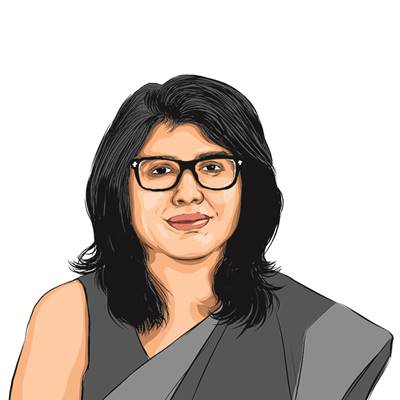Opinion Satyajit Ray’s women constantly negotiated with modernity
Though the film is called 'Nayak', it is the women I notice.
 Satyajit Ray. (Express archives)
Satyajit Ray. (Express archives) Though the film is called Nayak, it is the women I notice.
Not Arindam Mukherjee (Uttam Kumar), the actor protagonist forced to travel by train from Calcutta to Delhi to collect an award, but the woman, smart and sophisticated, freer than the nayak can be, free of the need to stay hydrated by adoration. She’s a journalist, and Satyajit Ray places their first encounter almost deliberately on the level of metaphor — he is sitting; she, having gone to get his autograph for a cousin, is standing, so that she literally looks down on him. He, affronted by her modernity, asks her whether she’s married — and, like other modern women now, doesn’t wear her marital status on her forehead — or a “bachelor”.
Aditi Sengupta (Sharmila Tagore) edits a woman’s magazine — Adhunika. The “a” attached as a tail to what is the name of a cultural phenomenon, an aesthetic, an argumentative tradition, genders it — the characteristics of the “adhunik” (modern) are transferred to the woman. For a man the word remains an adjective, letting the common noun stay separate — “adhunik purush”, a modern man. The woman, educated, probing with her questions, is given a pair of black-rimmed glasses almost to emphasise her being “modern”. The specs, often behaving like quotation marks in various scenes, are one of the many types of adhunika that Ray shows us. There are others — the young girl who watches the hero from the upper berth of her train, her fever almost a manifestation of the adoring fan’s tempest inside her; a businessman’s attractive wife, offered as a bribe to a man in an influential position, who, in this chance meeting with the nayak, is touched by the contagion of cinema and, through it, wants to stake a claim to the modern (Ray, all through the dialogue-heavy film, keeps making a case for cinema to be acknowledged as an experience and achievement of modernity).
There’s also Promila Chatterjee, the woman asking him for a role in his next film, who appears at the nayak’s house at night, and later in his dreams, proclaiming her talent and “ambition”. Ray ensures that the word is said in English, to retain its foreignness, as it slips out of a Bengali woman’s mouth. She is allowed another English word in the conversation: “Nervous”. Along with his presumed nervousness are words that the nayak uses for himself – restrained and “bhadro”, well-behaved; the modern woman, knocking at a man’s door at night for work, has lost these virtues.
In Ray’s stories, those written primarily for children, one notices the absence of women, to the point that one begins to pity Feluda and Professor Shanku, the way one occasionally does poor Aristotle, for instance, for not having had the privilege of acknowledging female intelligence. Like Virginia Woolf, who goes to Trevelyan’s book of social history to find out how women lived during certain periods of history, if we were to go to Ray’s film to see how women were getting by, we would see them as the men in their lives see them, almost as annexes of their social selves — an attractive wife who could bring business; a young girl dependent on the father; the girl’s mother, sweet and talkative, the kind of woman whom modernity might turn extinct. “Ambition”, “bachelor”, “BA Pass” and “unnati”, progress (“Apni unnati korben,” Uttam Kumar tells Tagore sarcastically) — words used for a male world are being imported into a characterisation of the “adhunika”.
In Pather Panchali (1955), the young girl Durga sees a train for the first time in her life — she encounters it through the senses, first through sound, a rumble that gradually grows into an intimidating monstrosity of smoke and speed that divides sky and screen. A decade later, moving from Bibhutibhushan Bandyopadhyay to his own script in Nayak, Ray puts the woman inside a train, one of the earliest ready-made metaphors of modernity. The world moves with gentle speed as the male actor and the female journalist speak. The man has to understand himself through his dreams; the woman is alert and awake, she asks the questions (she’s already criticised contemporary Bengali cinema for its lack of realism).
Ray turned to a tube of lipstick three years before Nayak, in his film Mahanagar, to characterise the unease caused by a working woman in a middle-class family. Autonit, the knitting gadget that Arati, the protagonist, has to sell, and the lipstick to which her Anglo-Indian colleague introduces her in Ray’s film about the city, both English words, have given way to a fountain pen, clipped to Tagore’s blouse. Madhabi Mukherjee resigns from her job in Mahanagar; Tagore tears the piece of paper which could have been published as an interview with the nayak.
This pattern of a constant negotiation with modernity, of adoption and rejection, argument and counter-argument, an acknowledgement of the elasticity of the adhunik, its capaciousness to accommodate the provisional, characterises Ray’s modern woman. What William Blake said of John Milton, that he was “of the Devil’s party without knowing it”, is perhaps true of the women in Ray’s films — that he was on the woman’s side without knowing it.
Roy, a poet and writer, is associate professor at Ashoka University. Views are personal



